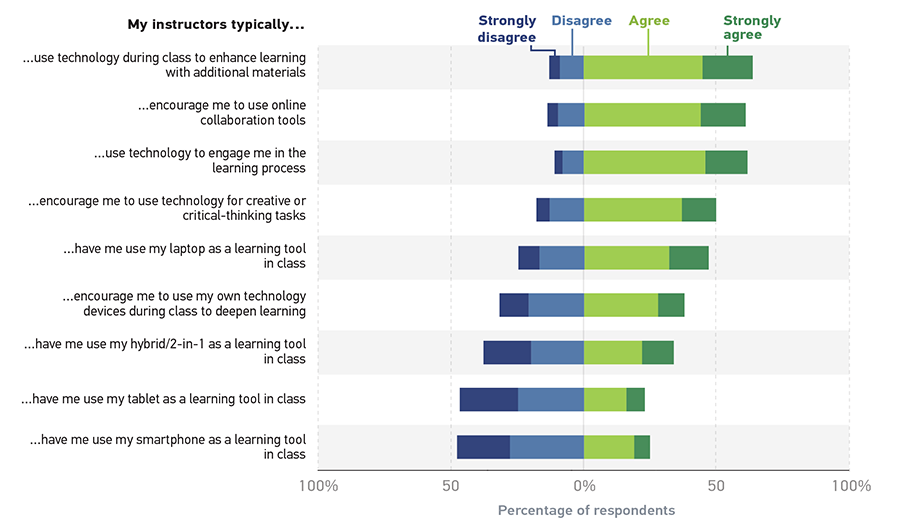Experiences with Instructors and Technology
To prepare for his driver's license exam, Oliver studies the driving handbook, memorizes road signs, and logs the state-required hours of behind-the-wheel training. He passes his exam with flying colors, but when he asks to borrow the car and drive by himself for the first time, mom and dad say "No." Their fears are certainly natural: They tell Oliver he's an inexperienced driver, and if he drives solo, they won't be there to correct him and prevent potentially serious mistakes. As he listens to his parents, though, Oliver wonders how he will ever continue to learn if he never gets the chance. Much like concerned parents, faculty are behind the wheel on how technology is used in their courses, and they may feel anxious about handing the tech keys over to their students in the classroom.
When we asked students about the different ways their instructors were using technology to teach, the majority told us instructors use tech to engage them in the learning process and enhance their learning with additional materials. Nearly half of students also agreed that their instructors encourage them to use technology for creative or critical-thinking tasks (see figure 6). These results signal that faculty are mostly comfortable with integrating technology to enhance their pedagogy, improve communication, and carry out course tasks—all good things for sure. These practices, though, are largely under the control of the instructor and are teacher-centered. Our data suggest a distinct break between these items and those where students were asked if they were encouraged to use their own devices in class—practices that involve some relinquishing of faculty control, are more student-centered, and can encourage more active learning pedagogies. While 38% of students said their instructors promoted the use of student-owned devices to deepen their learning, slightly fewer (32%) disagreed, which indicates that nearly a third of students are not asked, encouraged, or allowed to use their own devices as learning tools in class. Almost half of students agreed that instructors encourage them to use their own laptops to enhance in-class learning, but only a quarter said they were encouraged to use their smartphones, one of the most widely owned and used student-accessible technologies.

Students were not asked if their instructors banned personal devices in the classroom; nevertheless, our data, along with many qualitative responses (as in the following examples), suggest that students continue to experience rigid policies for using personal devices during class:
- "About half of the professors I've had over the course of my college career have not allowed laptops in the classroom to take notes. This is not helpful for me…."
- "I would like for professors to encourage using technology in class such as laptops for note-taking, rather than reprimanding us [for] using it."
- "Due to my disability, allow me to use my smart-pen Bluetooth connected to my smartphone."
Discouraging the use of or banning devices altogether, particularly laptops, robs students of tools they report as essential to their academic success; this can be problematic for underrepresented populations (see Device Access and Ownership), especially for students with disabilities.1 Allowing only students who have documented disabilities the use of digital devices can draw unwanted attention from their peers, effectively identifying them as having a learning need they are entitled to keep private. Students with undisclosed disabilities or learning differences may also be disadvantaged by indiscriminate technology bans, as disability disclosure rates by students are low in higher education.2 Allowing students to use their own technology is an inclusive and equitable teaching practice that stands to benefit far more students than we will ever know (for cases that go undisclosed and/or undiagnosed), but professional development in teaching with technology is needed to spread the word, especially in institutions where pedagogical training is not a requirement for faculty. Although trusting students with the keys to their own tech may feel uncomfortable or even scary, it allows faculty to test drive more student-centered teaching strategies and learn about and incorporate more of the tech tools students are already using in their academic work. Failing to leverage the power of student-owned devices is a missed opportunity to deepen student learning with technologies they are already licensed to drive.
Notes
-
Ruth Colker, "Universal Design: Stop Banning Laptops!" Cardoza Law Review 39 (2017): 483–93.
↩︎ -
Candace Cortelia and Sheldon H. Horowitz, The State of Learning Disabilities: Facts, Trends, and Emerging Issues (New York: National Center for Learning Disabilities, 2014); Noreen Glover, Timothy Janikowski, and Mary Handley, "Rehabilitation Counseling Student Disclosure of Disability and Use of Educational Accommodations," Rehabilitative Education 17 (2003): 224–36.
↩︎